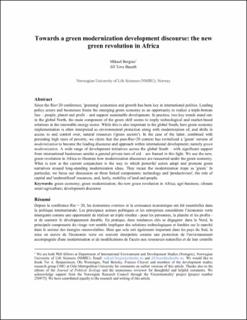| dc.contributor.author | Bergius, Mikael | |
| dc.contributor.author | Buseth, Jill Tove | |
| dc.date.accessioned | 2020-11-02T06:42:09Z | |
| dc.date.available | 2020-11-02T06:42:09Z | |
| dc.date.created | 2019-04-02T14:28:27Z | |
| dc.date.issued | 2019 | |
| dc.identifier.citation | Journal of political ecology. 2019, 26 (1), 57-83. | en_US |
| dc.identifier.issn | 1073-0451 | |
| dc.identifier.uri | https://hdl.handle.net/11250/2685956 | |
| dc.description.abstract | Since the Rio+20 conference, 'greening' economies and growth has been key in international politics. Leading policy actors and businesses frame the emerging green economy as an opportunity to realize a triple-bottom line – people, planet and profit – and support sustainable development. In practice, two key trends stand out: in the global North, the main component of the green shift seems to imply technological and market-based solutions in the renewable energy sector. While this is also important in the global South, here green economy implementation is often interpreted as environmental protection along with modernization of, and shifts in access to and control over, natural resources ('green sectors'). In the case of the latter, combined with persisting high rates of poverty, we claim that the post-Rio+20 context has revitalized a 'green' version of modernization to become the leading discourse and approach within international development; namely green modernization. A wide range of development initiatives across the global South – with significant support from international businesses amidst a general private turn of aid – are framed in this light. We use the new, Green Revolution in Africa to illustrate how modernization discourses are reasserted under the green economy. What is new at the current conjuncture is the way in which powerful actors adopt and promote green narratives around long-standing modernization ideas. They recast the modernization trope as 'green.' In particular, we focus our discussion on three linked components; technology and 'productivism', the role of capital and 'underutilized' resources, and, lastly, mobility of land and people. | en_US |
| dc.language.iso | eng | en_US |
| dc.relation.uri | https://journals.uair.arizona.edu/index.php/JPE/article/view/22862/21903 | |
| dc.rights | Navngivelse 4.0 Internasjonal | * |
| dc.rights.uri | http://creativecommons.org/licenses/by/4.0/deed.no | * |
| dc.title | Towards a green modernization development discourse? The new, green revolution in Africa | en_US |
| dc.type | Peer reviewed | en_US |
| dc.type | Journal article | en_US |
| dc.description.version | publishedVersion | en_US |
| dc.source.pagenumber | 57-83 | en_US |
| dc.source.volume | 26 | en_US |
| dc.source.journal | Journal of political ecology | en_US |
| dc.source.issue | 1 | en_US |
| dc.identifier.doi | http://doi.org/10.2458/jpe.v26i1 | |
| dc.identifier.cristin | 1689769 | |
| dc.relation.project | Norges forskningsråd: 250975 | en_US |
| cristin.unitcode | 192,13,1,0 | |
| cristin.unitname | Institutt for internasjonale miljø- og utviklingsstudier | |
| cristin.ispublished | true | |
| cristin.fulltext | original | |
| cristin.qualitycode | 1 | |

